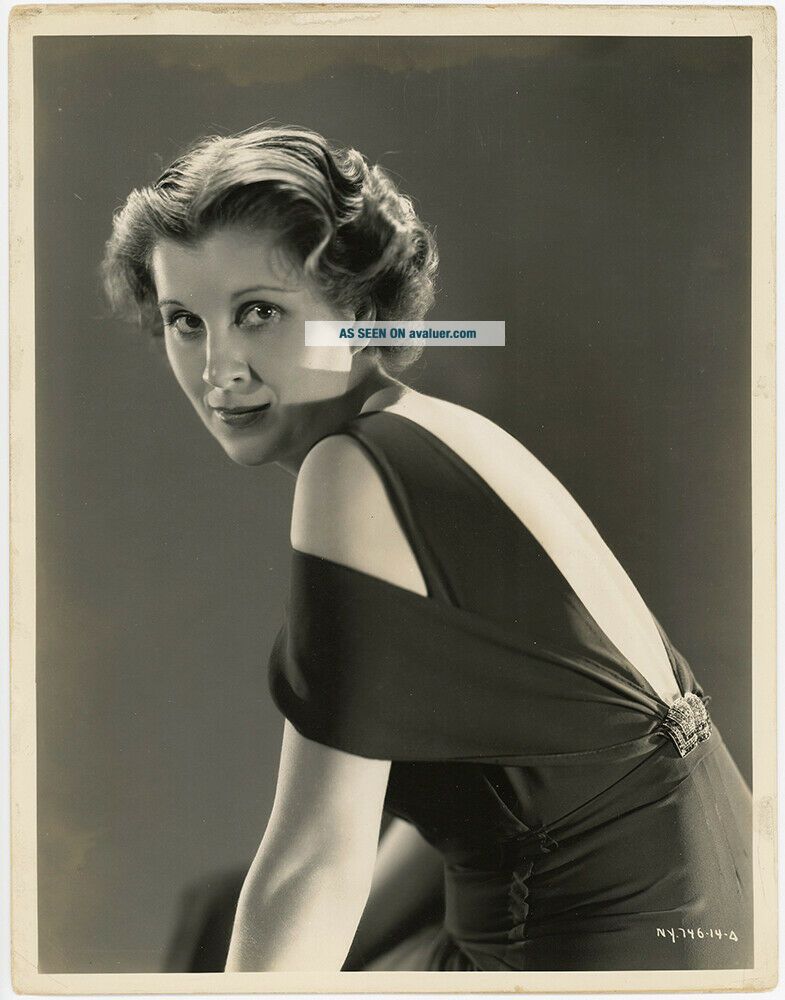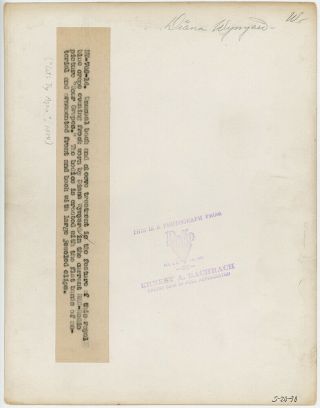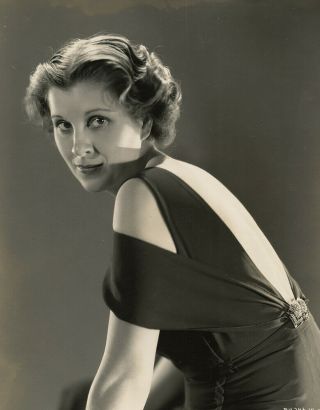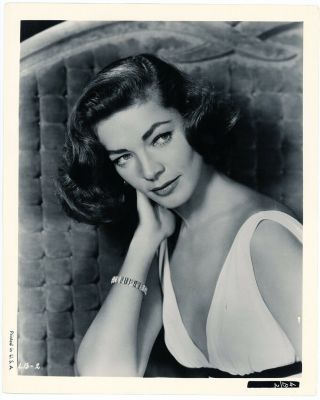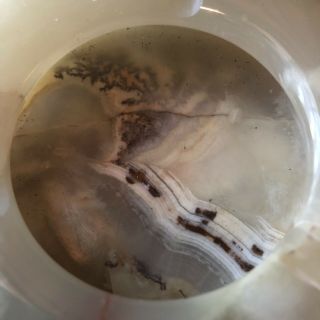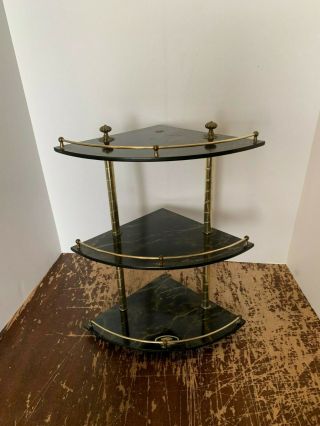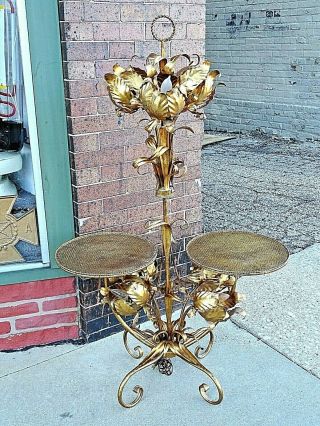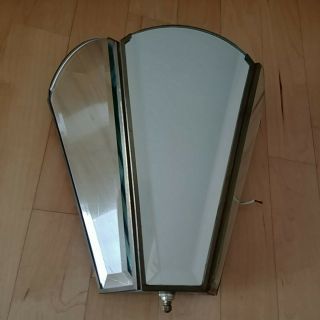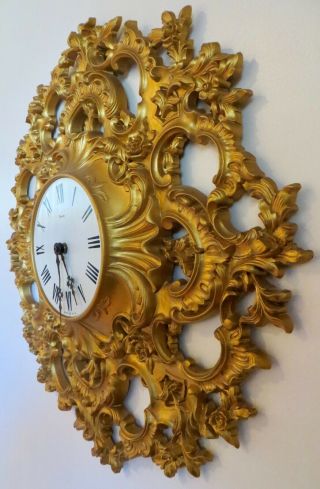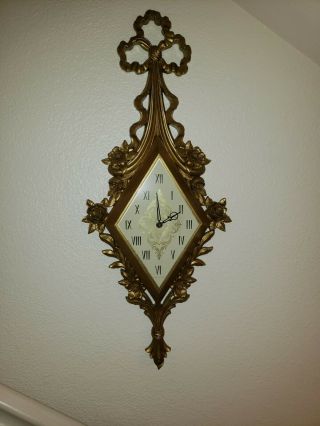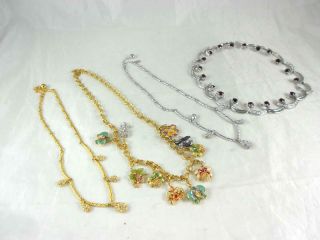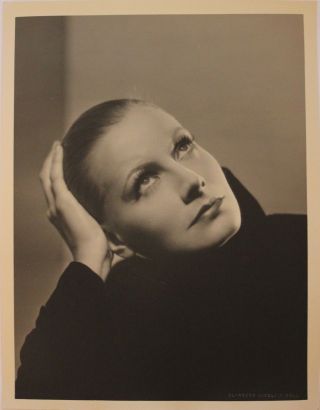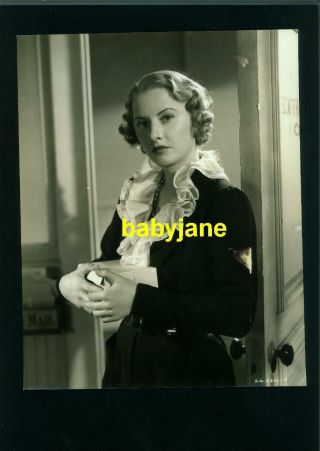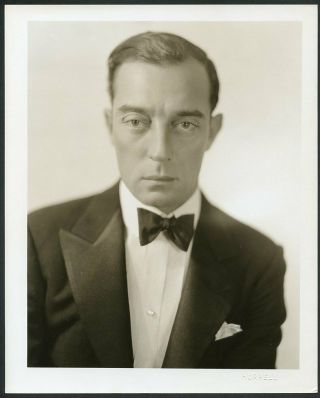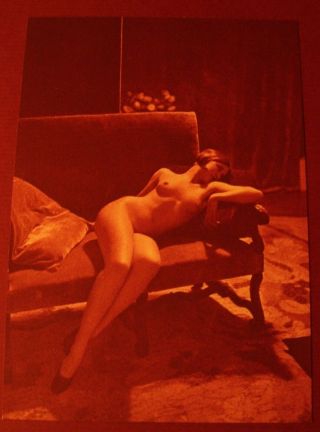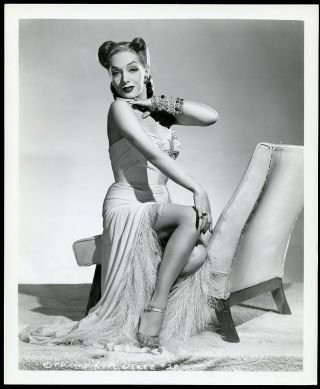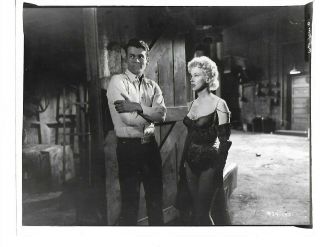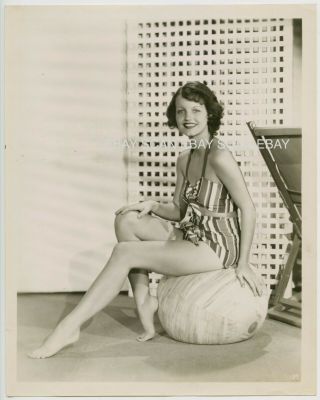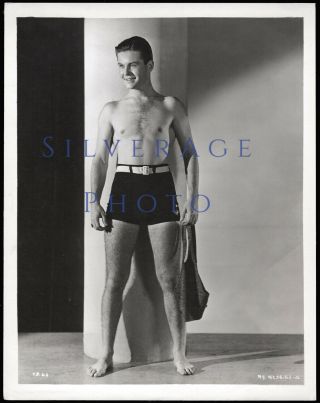Hollywood Regency Beauty Diana Wynyard Vintage 1934 Ernest A Bachrach Photograph
Item History & Price
Thanks to all our eBay bidders! We are honored to be your one-stop, 5-star source for vintage pin up, pulp magazines, original illustration art, decorative collectibles and ephemera with a wide and always changing assortment of antique and vintage items from the Victorian, Art Nouveau, Art Deco, and Mid-Century Modern eras. All items are 100% guaranteed to be original, vintage, and as described. Please feel free to contact us with any and all questions about the items and our p...olicies and please take a moment to peruse our other great eBay listings. All sell no reserve!
ITEM: This is a vintage and original RKO Radio Pictures studio portrait photograph taken by Ernest A. Bachrach of English stage and film actress Diana Wynyard. This photo was used in promotion of Wynyard's 1934 drama film Let's Try Again which is advertised in the press snipe under its working title of "Sour Grapes." This is a lovely Hollywood Regency glamour portrait that uses Wynyard's beauty to highlight the unique design of the evening gown that she models.
The press snipe reads, "Unusual back and sleeve treatment in the feature of this royal blue crepe evening frock worn by Diana Wynyard in the current RKO-Radio picture 'Sour Grapes.' The bodice is created with the flat bands of material and ornamented front and back with large jeweled clips."
Measures 8" x 10" on a glossy single weight paper stock.
Paper caption, photographer's ink stamp, and handwritten notations on verso.
CONDITION: Fine condition with scattered corner and edge wear, surface loss in the top margin, and scattered storage/handling wear throughout. Please use the included images as a conditional guide.
Guaranteed to be 100% vintage and original from Grapefruit Moon Gallery.
••••••••••••••••••••
One of the outstanding stage actresses of her time, Diana Wynyard will always be remembered for her unforgettable performance in the British version of the thriller Gaslight (1940) (re-made in Hollywood in 1944 with Ingrid Bergman). Starring opposite the great Anton Walbrook, she played the part of terrorized Bella Mallen (driven to the point of insanity by her evil husband) with an ethereal, haunted fragility. Diana Wynyard was educated at the Woodford School in Croydon and first appeared on the stage in London in 1925, debuting in 'Sorry, You've been Troubled' as Lady Sheridan. She soon became one of the great stars of the British theatre with a wide-ranging repertoire, which included Shakespeare, Chekhov and Shaw. In 1937, she played Eliza Doolittle in 'Pygmalion'.
In 1932, she was signed to a contract at MGM and was cast opposite the three Barrymores in Rasputin and the Empress (1932). However, her best performance was with Clive Brook in Noël Coward's Cavalcade (1933), for which she received an Academy Award nomination. The New York Times (June 6, 1933) remarked, "Miss Wynyard is excellent as Jane Marryot. She portrays her role with such sympathy and feeling that one scarcely thinks of her as an actress". Another review of Diana Wynyard, this time for One More River (1934), described her acting as 'stirringly sincere'. Her Hollywood career lasted only two years before the actress returned to England. She gave other sensitive performances in The Prime Minister (1941), with John Gielgud as Benjamin Disraeli, and The Remarkable Mr. Kipps (1941), with Michael Redgrave, both directed by Carol Reed. Her subsequent marriage to Reed lasted just four years. Diana Wynyard appeared in smaller supporting roles during the 1950s and, in keeping with her confession "I don't really want to be a film star", gradually returned to the Shakespearean stage. One of her last significant screen roles was as James Mason's mother in Island in the Sun (1957).
On stage, she played Beatrice, first opposite Anthony Quayle and later John Gielgud, in 'Much ado about nothing' (Australian tour, 1949-50). Other parts included Katherine in 'The Taming of the Shrew' and Hermione in 'The Winter's Tale'. Diana was awarded a CBE in 1953 for her contribution to the theatre. She never stopped working and gave her final performance as Gertrude to Peter O'Toole's Hamlet.
- IMDb Mini Biography By: I.S.Mowis
••••••••••••••••••••
Ernest A. Bachrach, By: Mary Mallory
Hollywood’s motion picture still photography defined sophisticated style, shaped personas and created the iconic image of “a movie star” as we know it today. The photographers’ dramatic lighting, dynamic compositions, artful negative retouching and artistic eyes influenced the American public’s perceptions of celebrities and their personalities. Stars were defined as sexy, glamorous, thoughtful, foreboding, all through the scintillating camerawork of these often unsung and forgotten men.
While photographers such as George Hurrell, Ruth Harriet Louise, Clarence Sinclair Bull, Lazslo Willinger and Eugene Robert Richee came to be recognized for their style as well as their artistic sensibilities, RKO’s chief photographer, Ernest Bachrach, gained fame for taking quality portraits that fitted whatever style was requested by art directors or studio publicity chiefs. His discerning eye easily captured the personal essence of the stars he shot, the most important element of a first-rate photographic image. As John Kobal quotes him in his book, “The Art of the Great Hollywood Portrait Photographers, ” “Portraiture is very closely akin to cinematography. The cinematographer has very little need for accessories in the making of close-ups; all he needs is a face and some lights and shadows. And that is all the portrait artist needs. Occasionally — but only occasionally — minor props are useful.”
Ernest Bachrach was born Oct. 20, 1899, in New York, and his early years are mostly unknown, though he did sign up for duty in World War I, starting his service at New York’s Ft. Slocum.
By the early 1920s, he was a stillsman for Famous Players-Lasky at their Astoria, N.Y., studio. John Kobal describes how Gloria Swanson came to admire Bachrach’s work as he shot stills for her New York films. Photographer Robert Coburn told him that for Swanson, “There was no other photographer in the world.”
When Swanson formed her own production company in 1926 and returned to Hollywood, she hired Bachrach to shoot portraits and stills for her films, including “Queen Kelly” (1928), “Sadie Thompson, ” (1928), and “The Trespasser” (1929). After Swanson’s company folded, RKO put him in charge of their newly created portrait gallery, where he would remain for most of his career.
As David Shields relates in his book, “Still: American Silent Motion Picture Photography, ” Bachrach mostly shot stars in full figure before cropping and blowing up images to create head shots, busts, and the like, as did several of his contemporaries like Max Munn Autrey, Ruth Harriet Louise and Jack Freulich. Bachrach focused on capturing expression and thought in his portraits, shaping them to suit whatever a particular medium or outlet required. His images seem alive with possibility as a result. His easygoing, friendly personality and disciplined style endeared him to stars and crew, creating a happy work environment, where his staff called him “Ernie.” His disposition and personality created a loyal, steady work force, including photographers Gaston Longet and Alexander Kahle.
While at RKO, Bachrach shot many of its outstanding stars, including Fred Astaire, Irene Dunne, Ginger Rogers and Katharine Hepburn. He connected particularly with Hepburn, capturing her intelligence, poise and flair in expressive photographs. She comments in Kobal’s book how Bachrach and other stillsmen covered flaws and faults in many women’s faces, creating goddesses out of sometimes ordinary faces.
Bachrach sometimes thought that photographers, along with the studios pushing them to turn out portraits, settled for pretty images that failed to firmly represent a star’s essence or individuality. He described in a 1932 article for American Cinematographer called, “Personality and Pictorialism in Photography, ” what he considered quality portraiture: “A primarily pictorial representation of that person’s personality, made by means of photography.”
Bachrach continually sought to improve his craft, shooting independent work to develop his skills in all areas of photography. Hollywood Reporter stated in its May 3, 1933, issue on his innovation of setting portraits on black mounting “unusually artistic.” He received several awards for his outstanding work, including the International Award at the 1933 Century of Progress Exposition in Chicago for “Finest portrait work in the world.” The Artists and Fellows of the Royal Photographic Society awarded him a diploma for his “achievement in exceptional graphic studies” at the Fair.
The artist sought to inform and educate his colleagues and the public in lighting, shooting and composing excellent photographs by writing articles for such magazines as American Cinematographer, International Photographer, Popular Photography and Silver Screen. In the July 1939 edition of Silver Screen, Bachrach noted that the first question a photographer should pose to his sitter was, “To whom are you giving it?” Photographs for parents, love interests, or jobs should all be lit and shot differently. Some of his articles focused on shooting for face shapes and body shapes, as well as technical aspects.
Besides shooting portraits, Bachrach often made time to shoot stills for important or artistic RKO films, such as “King Kong, ” “Little Women, ” “Sylvia Scarlett, ” “Citizen Kane, ” “The Secret Fury, ” “The Set-Up” and ‘Holiday Affair.”
Bachrach proudly served in various capacities for Local 659, the Cameraman’s Union, serving for years on its Executive Committee and various committees. He helped establish a cameraman’s salon to provide further opportunities in bettering their skills.
Outside of work, Bachrach focused his shooting skills as the leader of RKO’s crack rifle shooting team, composed of members of the photographic staff. The disciplined shooters placed 13th out of 133 teams in the 1936 United States small bore championship series.
Besides painting with light while shooting portraits, Bachrach also dabbled in actual painting, practicing the discipline of composing art true to life with oils and watercolors as well as chemicals, silver, and light.
By the late 1930s and early 1940s, Bachrach sometimes traveled to the East Coast to shoot portraits or stills for films. While traveling, he often visited with magazine art directors and editors to discern their needs for illustrating articles and covers. He also found time to travel to San Francisco “to make portraits of Katharine Cornell and her troupe in Rose Burke, ” per the Jan. 22, 1942, Variety.
When Local 659 organized a Stills Show with the Academy of Motion Picture Arts and Sciences in the 1940s, Bachrach often achieved recognition for his outstanding work. The photographer won certificates and first-place awards in 1942 and 1943. In 1947, Bachrach cleaned up at the last stills show, winning two first-place and two second-place awards, and the John Leroy Johnston Trophy for most popular still exhibited in the CBS Columbia Square foyer exhibit: an image of Rhonda Fleming superimposed on a human eye.
Bachrach found solace in work after his wife, Rae, died in 1949, staying busy writing articles, making portraits, and serving his union.
In October 1954, Bachrach retired from RKO after 25 years of work to go freelance and enjoy a little free time. He shot stills for “Around the World in 80 Days” and “Run of the Arrow, ” among others.
Ernest Bachrach passed away March 24, 1973, virtually forgotten by the film community. Thanks to the work of photography scholars like John Kobal and Mark Vieira in the 1980s-2000s, his outstanding skills are once again highlighted galleries, articles and books. While not as famous as photographers like George Hurrell, Ruth Harriet Louise, or Clarence Sinclair Bull, Ernest Bachrach ranks as their equal in creating elegant, iconic portraits defining stars’ personas to legions of movie fans around the world.
— Biography By: Mary Mallory c/o The Daily Mirror
••••••••••••••••••••



